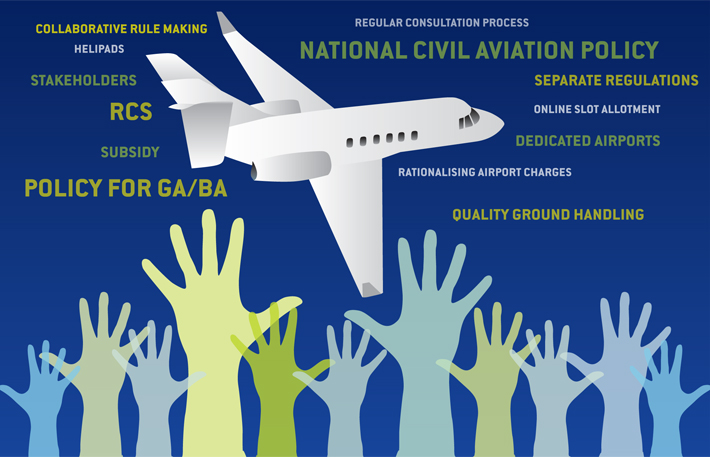Wings of Change
Unlocking India’s Business Aviation potential through rapid reforms and strategic investments
 | By SANJAY JULKA CEO TECHNICAL, AR AIRWAYS |

The golden age of Indian Aviation has begun. Business aviation is also seeing an increase in demand. In comparison to the pre-Covid yearly registrations of 40, 2022 saw 90 registrations/de-registrations. Globally, first-time customers boosted BA users by 50 per cent during and after Covid.
While demand for aviation is increasing, supply is causing concern in the sector. Investor confidence has yet to reach the targeted level. As a result, significant domestic and international investment is still pending. A major global player that entered the Indian market nearly a decade ago, is yet to add any aircraft to their modest fleet of two.
Infrastructure, regulatory and fiscal environment ranks are the three top variables contributing to diminishing supply and execution. The following paragraphs bring out some of the industry’s pain points.
INFRASTRUCTURE
Airports, hangarage for parking and maintenance, flying and AME schools, simulators, ATC training schools, FBOs, and other facilities serve as the foundation for growth. The government must not only improve the regulatory and tax environment, which would immediately attract investment in these industries, but it must also implement additional schemes such as UDAN and GIFT to support these vital aviation verticals.
REGULATORY ENVIRONMENT
Asset Based Financing. Scheduled operators receive asset-based financing, whilst non-scheduled operators have to battle for the same. This is mostly due to leasing companies’ unwillingness to invest time on 1-2 aircraft transactions. Furthermore, Indian leasing rules have failed to give lessors with assurances regarding repossession and asset management capabilities on VT registered aircraft. The government has done well in introducing the GIFT city concept, but unless these roadblocks of repossession and asset management are removed, and laws are brought up to world standards, asset-based leasing will not stabilise, and hundreds of entrepreneurs and aspiring multimillionaires in the country will be unable to purchase business planes. It’s weird that a car that isn’t tracked, traced, or audited as much as an airplane can get asset-based financing, but an aircraft that can’t move without government clearances and is tracked and audited by the DGCA at all times, cannot.
REFORMS MUST BE IMPLEMENTED AT A FASTER PACE. WE’VE BEEN TAKING BABY STEPS, WHICH HASN’T RESULTED IN THE REQUIRED MOMENTUM
Engine and Component Overhaul. Despite being the world’s third largest in terms of passenger traffic, India only retains one per cent of global MRO business, therefore we continue to spend millions of dollars in foreign currencies. To accommodate the planned development, the MRO business must be completely overhauled. OEMs should be encouraged to open MROs in India, even if under their own brands. This will allow Indian workers to be trained and qualified to open pure Indian workshops as achieved in the United States and Europe. Let us not forget that competence in MRO component and engine overhaul would be a need for starting manufacturing of planes in India. This must remain the industry’s ultimate goal.
DGCA. The DGCA’s regulations are stringent and outdated, and the approval processes are lengthy.
- 100h Additional Training for Captains: Following outdated laws, such as requiring 100 hours of actual flying time after training on Class D simulators, contributes to the pilot shortage situation. The number of pilots leaving one airline for another is projected to rise. We must recognise that a lack of licensed manpower poses a flight safety concern because airlines are held captive to the wants of licensed manpower and, rather than assuring greater skill levels of the crew, are seen wooing them in order to retain them. It is past time that we brought our legislation up to speed with international best practices, both for the benefit of flight safety and to accommodate rising demand. New types of aircraft are also difficult to introduce, owing to the 100-hour rule and then complex and time-consuming approval procedures.
- Dual Captaincy: All over Business Aviation community, a pilot flies two to three different types of aircraft at one time. DGCA also permits, but in its over cautious approach, it rarely approves dual captaincy. In some charter companies and private airlines, these pilots are flying approximately 200 hours a year whereas his optimum utilisation needs to be for approximately 1,000 hours a year. This gross under utilisation of pilots creates pilot shortages and related affects as explained in previous para. Dual Captaincy thus needs to be encouraged without inhibitions.
- Gross Under Utilisation in Helicopter Industry: State of Alaska alone has 9,000 helicopters. Compared to this, India has around 275. Helicopters are multi role machines. Besides passenger travel, it can be exploited in multitude of missions like, firefighting, medical evacuation, law enforcement, power line maintenance heavy lift missions, religious and heli-tourism, offshore oil rigs, photography, survey etc. India needs to take a quantum jump in other roles, for which it needs State Government support, in making helipads across the state, underwriting of seats and hours for medical and emergency relief operations. Another area that needs to be addressed is to exploit the next gen avionics and instrumentation in the helicopter. Our night flying rules for helicopters are archaic and we are insisting on Heli runways to conduct IFR operations, defeating the very purpose for which helicopters are designed.
- 18 Year Rule for Import of Aircraft: An airplane is built for cycles that last 40-50 years. This is a well-regulated business, and all aircraft activities are traceable, trackable, and auditable. There is no reason for an age restriction on aircraft imports. No such ban is enforced in developed countries. By imposing an age import barrier, a large number of citizens with low financial resources are unable to own and operate aircraft, stifling the expansion of aviation and, as a result, the nation.
- Mutual License Validation Across Registries: Mutual license validation takes time and includes physical inspections of facilities all across the world. This causes delays in training, maintenance, and even hiring personnel for operations like pilots or AME. It would be easier to introduce and operate new types of aircraft if such constraints did not exist. There is a lack of trust between India and the other registries that must be addressed.
- Examiner/Auditor Availability: There needs to be sufficient examiner availability in DGCA. If required, examiner or auditor availability can be supplemented by the industry by including DARs and DERs or retired pool of aviation professionals.
- Ease of Doing Business: Single-window concepts, time-bound monitored clearance from regulators, digital processing of clearances are some of the measures that will promote ease of doing business. Ease of doing business must also extend to all other civil aviation offices and ministries engaged in the operation of the aviation industry.
Unless the regulator follows the principle of keeping the aircraft in the air, processes will continue to be lengthy and complex.
FISCAL ENVIRONMENT
Tax/Royalty. As a communication industry, it is assumed that the government will provide subsidies or tax breaks to aviation, as communication development is a prerequisite for progress. On the contrary, business aviation aircraft import continues to be misunderstood as a luxury vehicle for the ultra-rich. This misunderstanding must be dispelled by giving examples from around the world, especially India, where the introduction of Business Aviation revolutionised places such as Raigarh. (See BizAvIndia Issue 1/2016). Higher taxes, such as GST or VAT on ATF, as well as customs duties, force users to seek alternatives outside. Because airplanes can be easily transported across countries and continents, the industry resorts to using foreign jets, parking or maintaining planes abroad. Three immediate areas of concern are:

- Custom Duty: Despite the industry’s demonstration of the indirect effect of aircraft induction on the country’s GDP, customs duties on import or private aircraft have yet to be repealed. We elected not to follow world-standard norms yet again, and this has stymied national growth of the country.
- Effects of Custom Duty on Parts Trading: Customs rules limit components from being used on aircraft other than the one for which they were imported; in other words, the government has placed restrictions on trading parts within the country. As a result, the majority of Indian traders have set up shop abroad and use foreign exchange to trade parts from these locations. A simple waiver of customs duty on all airplane components will allow for part trading in India.
- GST on Fuel and Services: Following the simple notion that aviation activities are conducted on a global platform, the tax and regulatory structure must be the same as, if not better than, the rest of the world. At times, it is less expensive to lease an aircraft from Dubai, fly to Mumbai, pick up a passenger, drop him off in London, and return to Dubai. This is due to reduced ATF taxes. Another place where opportunities are being lost.
THE GOVERNMENT MUST NOT ONLY IMPROVE THE REGULATORY AND TAX ENVIRONMENT, WHICH WOULD IMMEDIATELY ATTRACT INVESTMENT IN THESE INDUSTRIES, BUT IT MUST ALSO IMPLEMENT ADDITIONAL SCHEMES SUCH AS UDAN AND GIFT TO SUPPORT THESE VITAL AVIATION VERTICALS
RBI Restrictions to Remit Money Abroad. While the world is making payments by credit cards and instant bank transfers, our rules require RBI approval before remitting. Often this permission is given only after the DGCA gives permission or other pre-requisites are fulfilled. As a result good deals in the market get lost, thereby affecting Businesses adversely.
Fractional Ownership. It’s been over two years, and industry efforts to introduce fractional ownership have failed to bear fruit. Allowing multiple owners of an aircraft is a tried and established concept in other countries, and this will only encourage those on tight budgets to buy and operate aircraft. Some of the complexities are related to custom duty, and once again, if custom duty regulations are brought up to international standard norms, the concept of fractional ownership or distinct owneroperator will simply fall into place.
CONCLUSION
Not able to Exploit Cheap Labour. Because of an unfriendly tax and regulatory environment, the advantage of having inexpensive and capable English-speaking workers is lost. Imagine if this environment had been created to international standards, with a labour cost advantage, Indian aviation operators, MROs, training facilities, and other support services would have dominated the worldwide market. As a result, demand would have risen, investors would have acquired trust in the sector, and indigenous aircraft manufacturing would have commenced. Given that aircraft is part of the communication industry, the national economy would have benefited greatly. I believe that if this potential is now recognised, it will be the deciding element in propelling India into the top three, if not the top, economy in the world:
- Reforms must be Implemented at a Faster Pace: All stakeholders are aware of and accept the aforementioned pain issues. Reforms are being implemented. The pace of reform is excruciatingly sluggish. We’ve been taking baby steps, which hasn’t resulted in the required momentum. We must now change our pace of reforms. Likes of Tatas, Ambanis, Adanis, and Jindals must now be investing large sums in this industry.
- Task Force: A task force to bring the tax and regulatory structures up to pace, if not better, with the rest of the globe is required. Because aviation is a communication industry that indirectly affects the GDP of the entire nation, it will not be difficult for a well-intentioned government to obtain all required permissions to modify this environment. Everything will fall into place once the environment changes. The major industrialists will begin investing in aviation companies, aircraft purchases, simulators, MROs, component and engine overhauls, and, eventually, aircraft production. That is the light at the end of the tunnel, and we as industry expect the 2024 government to prioritise this task force.





